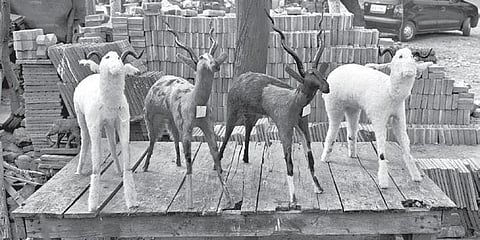

Photographer Gauri Gill has spent decades meeting and documenting Indian communities- -rural, urban, diasporic. Among the various projects that she has worked on over the years, ‘Rememory’, a series of urban landscapes that she began in 2003, has evolved to encompass evocative photographs of elements that make a city. As stated by art curator Natasha Ginwala, the series “excavates the collective debris of socio-political fantasies and failures through Gill’s lens” thereby highlighting tales of aspirations and alienation in cities. Currently on display at Galerie Mirchandani + Steinruecke, Mumbai, this series is a part of an exhibition titled Sheher, Prakriti, Devi, curated by Gill herself. We speak to the Delhi-based artist about the evolution of the photo series and her research process. Excerpts...
You started the series ‘Rememory’ in 2003. What was the initial intent and how has the series evolved over the years?
Beginning in 1999, I was spending a lot of time in rural India, travelling extensively and spending long stretches of time in Western Rajasthan. Emerging from sequestered time in the village I would encounter the city in a different way, and consider various aspects I had never noticed before. For instance, I rarely saw cupboards in the village, or gates restricting access, or stuffed animals. I began to document these oddities, or as I saw it then, the neuroses of urban life and people. The space between village and city in these border towns was also immensely productive, in that one could see all kind of hybridity emerge from it, for instance vernacular forms of architecture mixed in with influences from more cosmopolitan cities,
absorbed in turn from other countries and times. These homegrown forms contained a multiverse of aspirations and desires, versus the more impersonal buildings and interiors that emerge from global architects’ imaginations and might look the same from China to Mumbai. Over time new narratives emerged from the fragments I gathered in travels across small towns and large cities across India—how nature is transfigured and diminished in the city, the advertising that we observe and that observes and ultimately consumes us—in that we find ourselves
ultimately inside it—and so on.
How do you begin this photography project? Was there a research process to it?
Time is the laboratory I work in, and of photography itself, isn’t it? Things change across moments and years, as do we ourselves. The research is grounded upon years of repeated looking, visiting places to learn for myself, asking questions of people and places, and then retrospectively trying to connect the many, many dots.
The series has urban landscapes but no human beings. Why have city dwellers been kept out of the frame and what does their material absence signify?
Humans are everywhere in this series through what we make and how we aspire to live. ‘Rememory’ is in fact about the human hand and imagination at play. Here, I was primarily interested in what it is that we are choosing to build—our desires, world-making and habitations, rather than the human form itself.
Did this series in any way inspire your other works or does it intersect with other projects you're working on?
All the work has underlying themes and connections. For instance, I don’t believe that there is a landscape to be found out there as much as that our perception of the landscape comes from our own histories and individual readings of it, which is what Fields of Sight is about. In this exhibition, the typologies I have constructed from the fragments of the city called Rememory, are interwoven with the drawings from life by my mother Vinnie Gill, and the forms of the Devi as depicted by the Adivasi artist Ladhki Devi. Both are lifelong practitioners who have never exhibited their work before. All of the heartbreak, irony, analysis and so on in my own work—or world-making—is to be seen as emerging only from my own subjectivity, and therefore set against my mother’s drawings which are another kind of interpretation of the world, as intimate gestures of her love for trees, animals, mountains, trees and old tombs, a warm embrace of the natural world and spaces of refuge; and finally the multi-faceted female deities of Ladhki Devi that all women embody and that also created a way for us to transcend it all, or to speak to the metaphysical world. So the exhibition in Mumbai is called Sheher, Prakriti, Devi.
The series transcends time and space boundaries. Do you think monochromatic tones somehow add to the tension the photographs emulate?
Yes, I very much wanted to abstract the spaces and to focus us on the emotional content, if you will. In a way, these are psychological pictures of the city. It’s always hard for me to divorce feeling from my work, which is perhaps why I then spend years letting it sit so that I can distil it and think about it more conceptually. But the initial impulse is emotionally driven, and sometimes better suited to monochromatic tones, perhaps for that very reason.
INTERPRETATIONS OF THE WORLD
The exhibition titled Sheher, Prakriti, Devi features Forms of the Devi, 2020-2021 by Warli artist Ladhki Devi and Drawing from Life, 2019-20 by Vinnie Gill along with Gauri Gill’s ongoing series Rememory. For this exhibition, Ladhki Devi has created 14 representations of the Devi. Artist Vinnie Gill, who draws inspiration from nature. She has been experimenting with different mixed media including pastels, Chinese pigment paints, Rotring pens, watercolours, acrylics and oil paints. Both the artists are exhibiting for the first time. The exhibition is up until January 5.